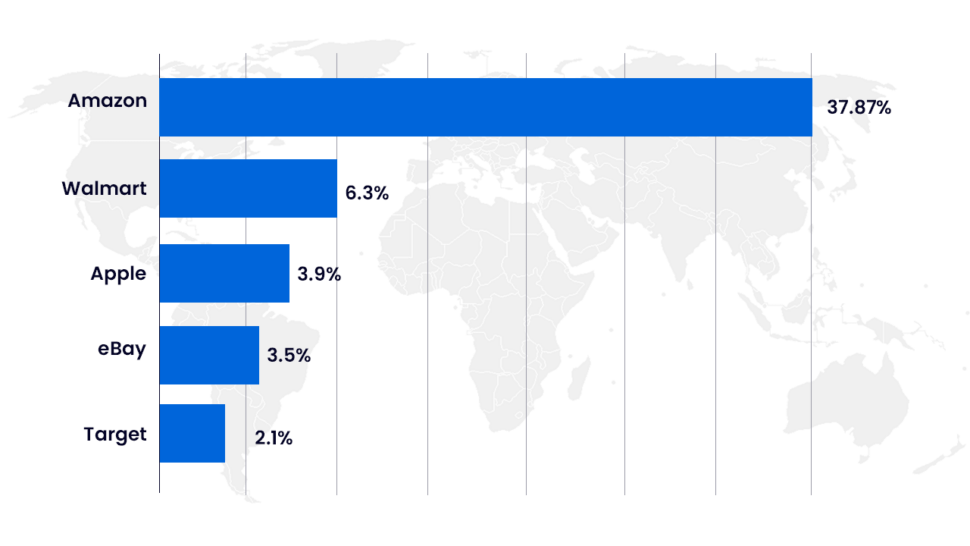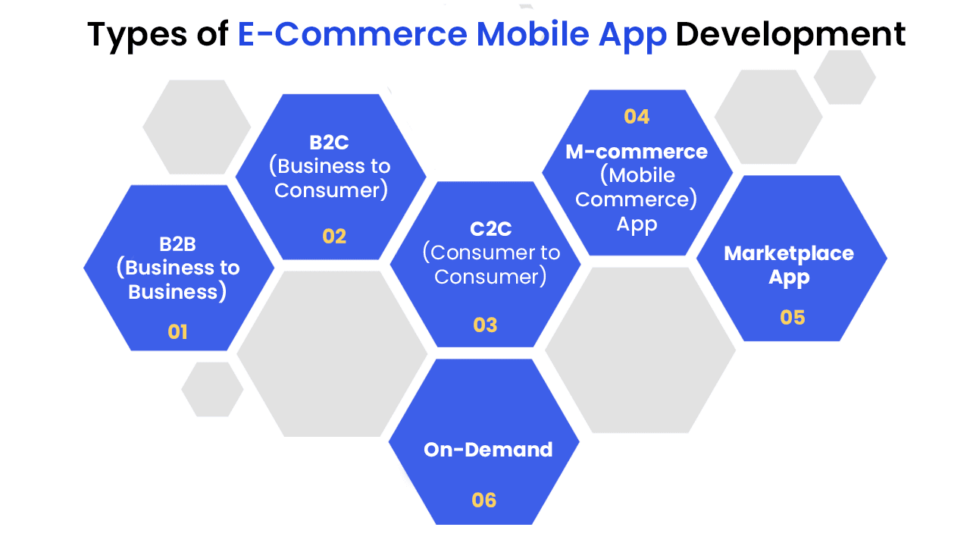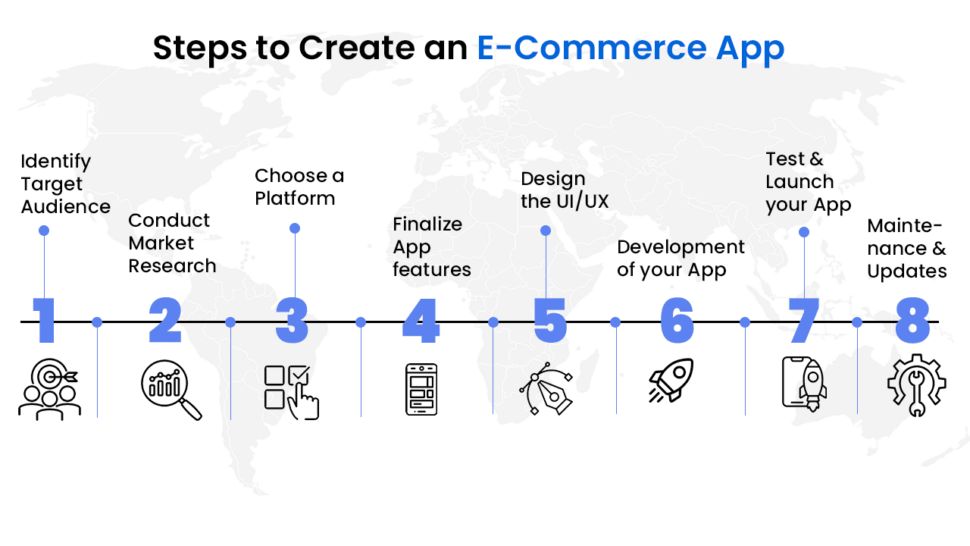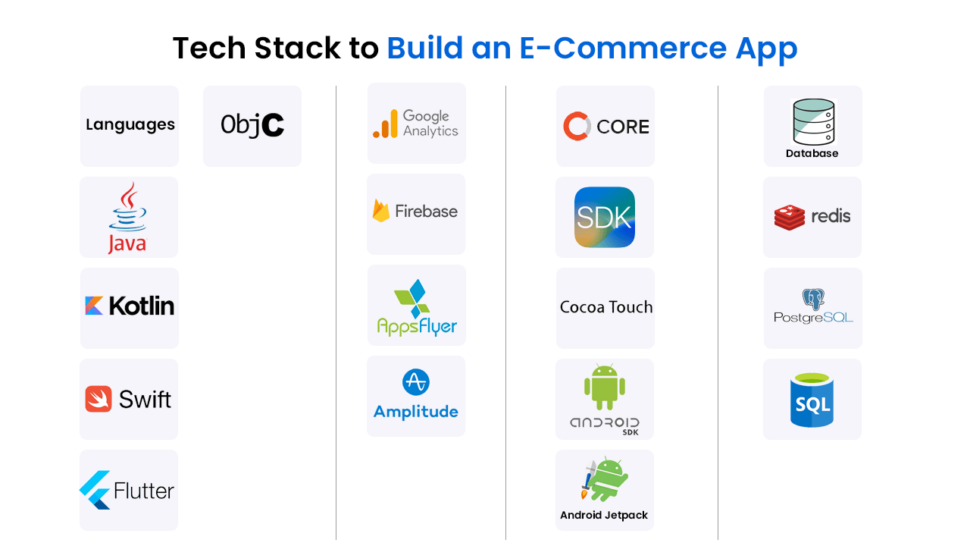E-commerce has become integral to our lives, and the industry is proliferating with e-commerce apps becoming a necessity and not a luxury anymore.
You don’t have to take our word for it. Just look at the impressive statistics to know how the e-commerce industry has grown, with businesses taking their products and services online in the last couple of years.
- According to Insider Intelligence, M-Commerce sales in the US are expected to be around $534.18 billion in 2024 from 360 billion in 2021 at a CAGR of 30% between 2020–2024.
- Smartphone commerce will make up 44% of all e-commerce sales by 2024.
- Reports show that the conversion rates from mobile apps are three times more than websites or mobile sites.
- Asia tops the list for the highest total e-commerce revenue with two trillion US dollars, with the US at the second largest at 1.1 trillion US dollars as per Statista.
- The number of mobile shoppers in the U.S. is expected to reach 187 million users by 2024, which you must tap into by going online.
- The top 5 leading e-commerce players in the US and their market penetration percentages are as follows.

Source: Statista
With online shopping gaining prevalence over the years and amidst such impressive statistics, if you are a business with a vision and wish to stay relevant, there are two things you must do, which are to take your business online and invest in e-commerce app development.
In this blog, we will show you how to build an e-commerce app from scratch. But before we go any further, we will see why the domain is relevant, and its types, and then proceed to know the steps to building an eCommerce app like Amazon.
Why You Need a Mobile App for Your Retail Store
Mobile apps have become essential tools for businesses across industries. Mobile apps are particularly important in the retail sector, as e-commerce app development offers several benefits for customers and retailers. Some of the benefits that it offers are given below.
Enhanced Customer Engagement
Mobile apps offer unparalleled customer engagement. With a mobile app, you can send push notifications directly to your customers’ smartphones, alerting them to special deals, promotions, or other important information. You can also integrate your app with social media platforms, enabling customers to share your products and promotions with friends and followers.
Helps Build Brand Loyalty
Mobile apps can help build brand loyalty by providing customers with a personalized experience. By allowing customers to create profiles and save their preferences, apps can cater to their specific needs and interests.
Moreover, customer loyalty can be rewarded with special discounts and promotions, strengthening the business’s and customers’ bond.
Increase Sales
Mobile apps can increase sales by making it easier for customers to browse and purchase products. Customers can shop from anywhere, at any time on the app, without the need to visit a physical store. Customers can also save their payment and shipping information, making the checkout process faster and more convenient.
Streamline Operations
Mobile apps can streamline operations by automating tasks like inventory management and orders. Integrating your app with existing systems can create a more efficient and cost-effective retail operation.
Gather Customer Data
Mobile apps can provide retailers with valuable customer data, such as shopping habits, preferences, and demographics. Businesses can gain insight into customers’ needs and behavior by analyzing this data and informing marketing and sales strategies.
Stand Out from the Competition
In today’s crowded market; a mobile app can be a powerful differentiator, helping to attract and retain customers in an increasingly competitive landscape and helping businesses stand out.
Types of E-Commerce Mobile App Development
B2B (Business to Business)
B2C (Business to Consumer)
C2C (Consumer to Consumer)
On-Demand
Marketplace App
M-commerce (Mobile Commerce) App
Mobile apps have revolutionized how we shop and have made online shopping easier, more convenient, and more accessible. They come in different types, each with its unique features and functionalities, and the following are some eCommerce mobile app types:

1) B2B (Business to Business) App
B2B apps are designed to facilitate transactions between businesses. They are commonly used by wholesalers, manufacturers, and suppliers to sell products and services to other businesses. These apps help businesses streamline their purchasing process and provide a more convenient way to place orders.
2) B2C (Business to Consumer) App
B2C apps enable businesses to sell products and services directly to consumers. These apps are used by retailers, service providers, and other businesses that want to reach a broader audience. B2C apps have become popular due to their convenience, 24/7 availability, and easy access to a wide range of products and services.
3) C2C (Consumer to Consumer) App
C2C apps are designed to facilitate transactions between individual consumers. Individuals can use these apps to sell their products and services to other individuals. These apps have become popular due to their low costs, flexibility, and ability to reach a broad audience.
4) On-Demand Apps
On-demand apps are designed to provide services on demand. These apps are used by service providers such as Uber, Lyft, or DoorDash, which offer ride-sharing, food delivery, and courier services. On-demand apps offer real-time tracking, payment processing, and scheduling features.
5) Marketplace App
Marketplace eCommerce apps are designed to facilitate transactions between multiple sellers and buyers. Shoppers use apps like Amazon, Etsy, and eBay, which offer various products and services from different sellers. Marketplace apps have become popular due to their convenience, the ability to provide a wide range of products, and competitive pricing.
6) M-Commerce (Mobile Commerce) App
M-Commerce apps are designed to enable users to shop online through their mobile devices. These apps are used by businesses that want to provide customers with a convenient way to shop on the go, optimized for smaller screens and touch-based interactions.
Features your E-Commerce App Must Have
With the increasing trend of online shopping, businesses need to ensure their e-commerce app has all the necessary features to attract and retain customers. Here are the ten must-have features in an e-commerce app before commencing the e-commerce application development process.
1. User-friendly interface: The first impression of an e-commerce app is critical to user engagement. The app must have an intuitive interface that allows customers to navigate seamlessly through the app.
2. Product listing: An e-commerce app must display products in an organized and visually appealing manner. A well-organized product listing makes it easier for customers to find what they want.
3. Search functionality: A search bar is a vital feature in an e-commerce app that helps customers find products quickly. The search function must be easy to use and provide relevant results.
4. Shopping cart: A shopping cart is where customers add products before purchasing. The app must have a simple and user-friendly shopping cart that allows customers to add, remove and update products.
5. Payment Gateway Integration: An e-commerce app must have a secure and reliable integration that supports multiple payment methods.
10. Order tracking: After placing an order, customers expect to be able to track their orders quickly. The app must have a real-time order tracking feature that lets customers know their orders’ status.
11. Customer support: An e-commerce app must have excellent customer support to ensure customers are satisfied with their purchases. A chatbot, phone number, or email address for support should be available.
12. Personalization: Personalization is a crucial feature that helps e-commerce apps stand out. The app must have personalized recommendations and a personalized shopping experience for each customer.
13. Reviews and ratings: Reviews and ratings are essential to building customer trust. The app must have a review and rating system that allows customers to provide feedback and share their experiences.
14. Security: Security is a crucial feature that e-commerce apps must have. The app must be secure and protect customer data with SSL encryption, two-factor authentication, and other security measures.
Steps to Create an E-Commerce App
Creating an e-commerce app can be a daunting task, but with the right approach and strategy, following a step-by-step e-commerce development process can help.
Identify Target Audience
Conduct Market Research
Choose a Platform
Finalize App features
Design the UI/UX
Development of your App
Test and Launch your App
Maintenance and Updates

Identify Target Audience
You need to understand your potential customers’ demographics and purchasing behavior. This information will help you create an e-commerce app that resonates with your target audience and provides them with the needed features.
Conduct Market Research
Once you have identified your target audience, conduct market research to understand the competition in the e-commerce industry. Analyze the strengths and weaknesses of your competitors and use this information to create a unique selling proposition for your app. You can also use market research to identify the gaps in the market and find opportunities for innovation.
Choose a Platform
Several options are available to build an e-commerce app., including iOS, Android, and web-based apps. You should choose a platform based on your target audience and device preferences. If your target audience primarily uses Android devices, you should focus on developing an Android app. You can opt for a hybrid approach if the audience is on Android and iOS.
Finalize App features
Your app should have all essential features, such as an attractive product listing, an easy-to-use shopping cart, a payment gateway, and order tracking features. You can also add social sharing, customer reviews, and personalized recommendations for user experience and make your app stand out.
Design the UI/UX
Your app design should be user-friendly and intuitive, making it easy for your customers to navigate and purchase. You should also focus on creating a consistent brand image throughout your app, including using colors, typography, fonts, and imagery.
Development of your App
You can hire professional app developers in-house or outsource the process to a remote software development team to build an e-commerce app. Consider the programming languages and frameworks if you’re developing your app from scratch. The following is the tech stack you can use to build an e-commerce app.

| Languages | Java |
| Kotlin | Swift |
| Flutter | Objective-C |
| Analytics | Firebase |
| AppsFlyer | Amplitude |
| Core | iOS SDK |
| CocoaTouch | Android SDK |
| Android Jetpack | Database |
| Redis | PostgreSQL |
| MySQL |
Test and Launch your App
Before launching your app, you must test it thoroughly to ensure it functions properly. You should test your app on multiple devices and operating systems to ensure it works correctly (it will help to conduct user testing to get feedback from potential customers and make any necessary changes to improve the user experience).
After reviewing all the guidelines, you can launch your app on the respective app store. You should also promote your app through various channels, such as social media, email marketing, and paid advertising.
Also read: How to publish an app to Google Play Store? Step-by-step guide
Maintenance and Updates
Once your app is launched, you should monitor its performance regularly by analyzing user behavior, tracking sales, and monitoring reviews to identify any areas of improvement. You should also update your app regularly to add new features and fix bugs or issues.
Ongoing E-Commerce App Trends You Must Know
With the growth of mobile technology, e-commerce apps are becoming more popular among consumers as they offer an easy and convenient way to shop online. We will discuss the top 11 e-commerce app trends that you must know.
1. Mobile Shopping is Increasing Rapidly
Mobile shopping has become increasingly popular over the last few years. In 2021, mobile e-commerce sales in the United States exceeded 360 billion U.S. dollars of total e-commerce sales. By 2025, the figure is expected to grow twofold, amounting to 710 billion U.S. dollars, according to Statista. With the growing popularity of mobile devices, e-commerce companies are focusing more on mobile optimization to improve the user experience.
2. Voice Commerce is on the Rise
Voice commerce is another e-commerce trend that is on the rise. With the growth of smart speakers and virtual assistants, voice commerce is becoming more popular among consumers. According to Statista, e-commerce purchases made through voice assistants are expected to reach 19.4 billion U.S. dollars in 2023 from 4.6 billion U.S. dollars in 2021 which is a 400% increase in just two years.
3. Augmented Reality (AR) is Changing the Game
Augmented reality (AR) is a technology that overlays digital information in the real world. This technology is changing the way people shop online. With AR, customers can try on clothes, see how furniture would look in their homes, and even see how the makeup would look on their faces.
4. Artificial Intelligence (AI) is Improving Personalization
Artificial intelligence (AI) is becoming more prevalent in e-commerce. AI is being used to improve the personalization of e-commerce apps. With AI, e-commerce companies can provide personalized recommendations, customized pricing, and targeted advertising.
5. Social Media Integration is Key
Social media integration is becoming increasingly important for e-commerce companies. By integrating social media into their apps, companies can reach a wider audience and improve their social media presence, improving the user experience by allowing customers to share their favorite products with friends easily.
6. Progressive Web Apps (PWA) are Growing in Popularity
Progressive web apps (PWA) are becoming more popular among e-commerce companies. PWAs are web applications that are designed to work seamlessly across all devices. They are faster than traditional web apps and provide a better user experience.
7. Mobile Wallets are Becoming the Norm
Mobile wallets are increasingly becoming helpful among consumers, where they can easily make payments using their mobile devices. They are typically made to be more secure than traditional payment methods, using encryption technology to protect customer information.
8. Subscription Services are on the Rise
Subscription services are becoming popular among e-commerce companies, and this model is increasingly popular for beauty and wellness products. With subscription services, customers can receive products regularly, such as monthly or quarterly.
9. Influencer Marketing is on the Rise
Influencer marketing is becoming more prevalent in e-commerce. By partnering with influencers, e-commerce companies can reach a wider audience and improve their social media presence. Influencers can also provide valuable feedback on products, which can improve the user experience.
10. Personalized Chatbots are Improving Customer Service
Personalized chatbots are providing instant customer service and support, which improves the user experience and offer a more personalized experience for their customers.
11. Omnichannel Retail is the Future
Omnichannel retail is becoming the future of e-commerce. With omnichannel retail, customers can shop across multiple channels, such as online, in-store, and mobile. This provides a seamless shopping experience for customers, regardless of where they are shopping.
Cost to Build an E-Commerce App
E-commerce app development costs can vary greatly depending on several factors, including the region in which the app is being built, the app’s complexity, the design, the platform, and the features that are needed. The following are rough estimates; the actual cost may vary depending on project needs. Therefore getting a cost estimate from the e-commerce app development company can help.
The following are rough cost estimates and a timeline for building an e-commerce app based on complexity.
| E-Commerce App Type | Cost | Time |
| Basic App | $30,000 – $50,000 | 2-3 Months |
| Mid-Range App | $50,000 – $150,000 | 5-8 Months |
| Complex | $150,000 – $500,000+ | 9-12 Months |
Building an e-commerce app in the US and UK can be high, and the e-commerce app development cost in Asia and Latin America is generally much lower. Ultimately, the best way to determine the cost of building an e-commerce app is to consult a development team and get a quote based on your needs and requirements.
| Region | Approximate Average Cost |
| USA | $50,000 to $100,000 |
| UK | £50,000 to £200,000 |
| Asia | $10,000 to $70,000 |
| Latin America | $10,000 to $100,000 |
How Ailoitte Can Help Build Your E-Commerce App
Creating an e-commerce app may not be a simple task, but it’s also not overly complex. Collaborating with the appropriate technological partner makes designing a distinctive and captivating mobile app for your enterprise feasible in just a few months. And this is where we can help.
Ailoitte is a leading software development company that can help build your e-commerce app. The company has a team of experienced developers who can create a custom app tailored to your business needs and provide your customers with the best possible experience.
The following are some ways Ailoitte can help you with its e-commerce app development services.
- Consultation and Planning: The team can work with you to create a project roadmap, identify key milestones, and establish timelines and budgets for your project.
- User Experience: You need to create a user-friendly and visually appealing e-commerce app, we can help with that.
- Multi-Platform Development: Ailoitte can build your e-commerce app compatible with multiple devices and operating systems, including Android, iOS, and the web.
- Integration with existing systems: If your business already has existing systems, we can help integrate these systems with your e-commerce app to streamline operations, reduce errors, and improve overall efficiency.
- Integration with Third-Party Services: We can help you integrate your e-commerce app with third-party services such as payment gateways, shipping providers, and social media platforms to streamline your business operation.
- Security and Testing: We take security seriously and help ensure your e-commerce app is secure and protected from threats.
- Maintenance and Support: Ailoitte can provide ongoing maintenance and support services to ensure your e-commerce app is always up-to-date and functioning correctly.
FAQ
You can choose based on the target audience you wish to reach and the platform penetration. Android and iOS have a significant market share presently, and you can target both and design an app that can function on both.
The best examples of mobile e-commerce apps are Amazon, eBay, Walmart, H&M, Alibaba, etc.
The five essential requirements for e-commerce are having a mobile-friendly website and app, smart shopping with shipment integration, a proper payment gateway, customer support, security, and privacy.
The six major types of e-commerce businesses are B2B (Business to Business), B2C (Business to Consumer), C2C (Consumer to Consumer), On-Demand Apps, Marketplace Apps, and M-commerce Apps.
The average cost to create a good quality app starts from $30,000 and can go up to $300,000 for a feature-rich app.




















.png)
.png)
.png)



Leave a Comment